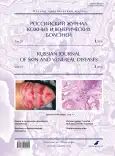A difficult patient at a cosmetologist appointment: early lip changes in women smokers: causes, and methods of correction
- Authors: Shirshakova M.A.1, Morozova E.A.2
-
Affiliations:
- Medical practice center
- I.M. Sechenov First Moscow State Medical University (Sechenovskiy University)
- Issue: Vol 23, No 1 (2020)
- Pages: 57-64
- Section: COSMETOLOGY
- URL: https://journal-vniispk.ru/1560-9588/article/view/41909
- DOI: https://doi.org/10.17816/dv2020157-64
- ID: 41909
Cite item
Abstract
A smoker’s lips are more likely to change because of exposure to reactive oxygen species that contain oxygen in large quantities in tobacco smoke. Oxidative stress is a crucial factor in the development of smoking-related diseases, such as oral cancer, lung cancer, and chronic obstructive pulmonary diseases. The damaging effect occurs because of the imbalance between the generation of reactive oxygen species and their detoxification. Markers of oxidative stress include parameters of lipid peroxidation, the activity of glutathione and antioxidant enzymes, and oxidative DNA damage. The destruction of hyaluronic acid (HA), the only drug used to correct lip changes, in smokers is accelerated by its participation in reactions with active oxygen forms, and not just by pathemization because of enzymatic cleavage by hyaluronidase. Mannitol has strong antioxidant properties, which makes it an ideal auxiliary substance in the composition of fillers based on HA. The role of reactive oxygen species in the aging process and their effects on both endogenous HA and HA-based drugs developed for esthetic use are discussed. A review of drugs, based on mannitol with hyaluronic fillers, is provided. The inclusion of mannitol in hyaluronic fillers is an effective and safe way to improve both short-term and long-term esthetic effects of the HA injection.
Keywords
Full Text
##article.viewOnOriginalSite##About the authors
M. A. Shirshakova
Medical practice center
Author for correspondence.
Email: doc.elene@mail.ru
Russian Federation, Moscow, 127473
Elena A. Morozova
I.M. Sechenov First Moscow State Medical University (Sechenovskiy University)
Email: doc.elene@mail.ru
ORCID iD: 0000-0001-5826-5018
MD, PhD, postgraduate of Department
Russian Federation, Moscow, 119991References
- Gubanova E.I. Lips. Forms and aging. Aesthetic Atlas. Moscow: Vallex M; 2009. (in Russian)
- Pavlou P., Rallis M., Deliconstantinos G., Papaioannou G., Grando S.A. In-vivo data on the influence of tobacco smoke and UV light on murine skin. Toxicol. Ind. Health. 2009; 25(4-5):231-9.
- Benowitz N.L., Jacob P. Metabolism of nicotine to cotinine studied by a dual stable isotope method. Clin. Pharmacol. Ther. 1994; 56(5):483-93.
- Harman D. Aging: a theory based on free radical and radiation chemistry. J. Gerontol. 1956; 11(3):298-300.
- Harman D. Free radical theory of aging. Mutat. Res. 1992; 275(3-6): 257-66.
- Yin L., Morita A., Tsuji T. Alterations of extracellular matrix induced by tobacco smoke extract. Arch. Dermatol. Res. 2000; 292(4):188-94.
- Wallstrom M., Sand L., Nilsson F., Hirsch J.M. The long-term effect of nicotine on the oral mucosa. Addiction. 1999; 94(3):417-23.
- Gottipati K.R., Poulsen H., Starcher B. Passive cigarette smoke exposure inhibits ultraviolet light B-induced skin tumors in SKH-1 hairless mice by blocking the nuclear factor kappa B signalling pathway. Exp. Dermatol. 2008; 17(9):780-7.
- Rowe R.C., Sheskey P.J., Cook W.G., Fenton M.E., eds. Handbook of Pharmaceutical Excipients. 7th ed. Washington DC: Pharmaceutical Press; 2012:479-82.
- Paterson I., Klausner J.M., Goldman G., Pugatch R., Feingold H., Allen P., et al. Pulmonary edema after aneurysm surgery is modified by mannitol. Ann. Surg. 1989; 210(6):796-801.
- Nicholson M.I., Baker D.M., Hopkinson B.R., Wenham P.W. Randomized controlled trial of the effect of mannitol on renal reperfusion injury during aortic aneurysm surgery. Br. J. Surg. 1996; 83(9):1230-3.
- Shah D.M., Bock D.E., Darling R.C., Chang B.B., Kupinski A.M., Leather R.P. Beneficial effects of hypertonic mannitol in acute ischemia-reperfusion injuries in human. Cardivasc. Surg. 1996; 4(1):97-100.
- Oredsson S., Plate G., Qvarfordt P. The effect of mannitol on reperfusion injury and postischemic compartment pressure in skeletal muscle. Eur. J. Vasc. Surg. 1994; 8(3):326-31.
- Karibe H., Zarow G.J., Weinstein P.R. Use of mild intraischemic hypothermia vs mannitol to reduce infarct size after temporary middle cerebral artery occlusion in rats. J. Neurosurg. 1995; 83(1):93-8.
- Ishikawa K., Osato S., Oda A., Ogawa I., Kadowaki H., Shimizu M., et al. Effects of mannitol in the prevention of evolving myocardial infaction. Jpn. Circ. J. 1988; 52(4):369-75.
- Laskowski H., Minczykowski A., Wysocki H. Mortality and clinical course of patients with acute myocardial infarction treated with streptokinase and antioxidants: mannitol and ascorbic acid. Int. J. Cardiol. 1995; 48(3):235-7.
- INCHEM. Chemical safety information from intergovernmental organizations. Mannitil. [Available at: http://www.inchem.org/documents/jecfa/jecmono/v21je10.htm. Assessed 10 March 2016]
- Smith W.W., Finkelstein N., Smith H.W. Renal excretion of hexiols (sorbitol, mannitol and dulcitol) and their derivatives (sorbitan, isomannide and sorbide) and of exogenous creatinine-like chromogen in dogs and man. J. Biol. Chem. 1940; 135:231-50.
- Morita A. Tobacco smoke causes premature skin aging. J. Dermatol. Sci. 2007; 48(3):169-75.
- Babior B.M., Kipnes R.S., Curnutte J.T. Biological defense mechanisms. The production by leukocytes of superoxide a potential bactericidal agent. J. Clin. Invest. 1973; 52(3):741-4.
- Kim H., Park K.Y., Choi S.Y., Koh H.J., Park S.Y., Park W.S., et al. The efficacy, longevity and safety of combined radiofrequency treatment and hyaluronic acid filler for skin rejuvenation. Ann. Dermatol. 2014; 26(4):447-56.
Supplementary files










